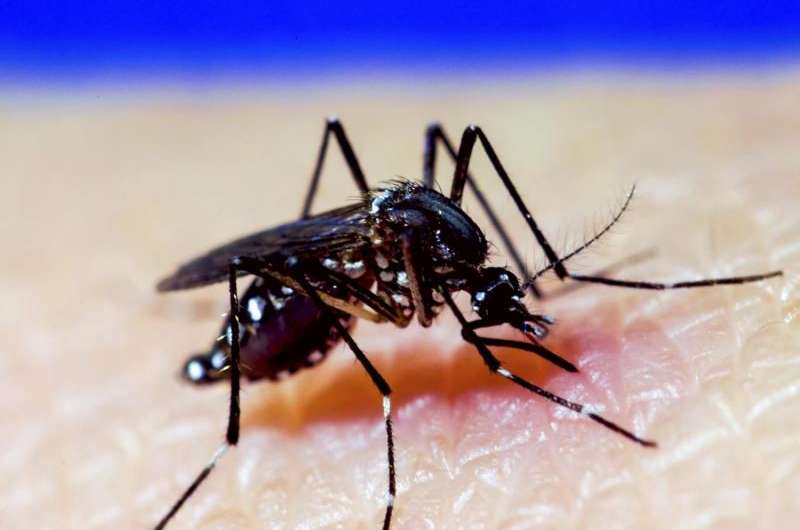Wolbachia parasite superinfection: A new tool to fight mosquito arbovirus transmission

Aedes aegyptimosquitoes transmit a number of pathogens, including the Dengue, Chikungunya, and Zika viruses.Wolbachia, a bacterium that naturally infects many insect species but notAedes aegypti, can nonetheless be introduced into theAedes aegyptipopulation and then block virus replication in the infected mosquito host. As with any antiviral strategy, the potential development of resistance by the virus is a concern. A study published on Feb. 18, inPLOS Pathogensreports on a strategy to make it harder for Dengue (and possibly other viruses) to developWolbachiaresistance.
Wolbachiaare vertically transmitted by femalemosquitoesto their offspring, and a phenomenon called "cytoplasmic incompatibility" gives infected females a reproductive advantage: they can mate and produce viable (and infected) offspring with infected or uninfected males, whereas the cross between uninfected females and infected males doesn't produce progeny. Over time, these mating outcomes facilitate the replacement of a local, nativeAedes aegyptipopulation by aWolbachia-carrying mosquito population—and recent field trials in five countries have confirmed this to be the case. Because theinfected mosquitoesare resistant to being infected by Dengue, Chikungunya and probably Zikavirus, this approach should reduce the number of human cases over time and potentially lead to local elimination of these arboviruses.
Cameron Simmons from the University of Melbourne in Parkville, Australia, and Scott O'Neill, from Monash University in Clayton, Australia, are involved in these field trials. Besides examining the effect on Dengue virus disease in human, they, together with colleagues, are also working on further improvements to the use ofWolbachiain Dengue control. One concern is that the virus will mutate and eventually be able to multiply even inWolbachia-infectedAedes aegyptihosts. One way to make this harder—at least in principle—is to increase the number or type ofWolbachiaparasites in the host cells. To this end, the researchers explored the possibility of "superinfection", namely the secondary infection of mosquitoes that already carry one strain ofWolbachiawith a second one.
For a second infection to rapidly spread into a population already carrying oneWolbachiastrain, it must benefit from cytoplasmic incompatibility, and the second strain must not reduce the fitness of the mosquitoes. And in order to reduce the risk for the development of viral resistance, mosquito hosts that are co-infected must have higher levels ofWolbachiaparasites in the host cells that the virus uses for replication.
In this paper, the researchers report the generation of superinfectedAedes aegyptimosquitoes that fulfill these criteria. The firstWolbachiastrain is calledwMel, and it is the one that is currently spreading through wildAedes aegyptipopulations as part of the ongoing field trials. The second strain, calledwAlbB, has similar characteristics in singly infected mosquitoes: it grows to relatively high densities in infected mosquitoes and does not diminish their fitness. (A third strain that has also been developed and tested grows to higher densities—and these are associated with stronger inhibition of virus replication—but the infected mosquitoes are less fit and therefore do not spread the infection as efficiently).
The researchers found thatAedes aegyptimosquitoes infected with bothWolbachiastrains showed normal fitness and had higher parasite densities than mosquitoes infected with either one of theWolbachiastrains alone. Moreover, the two parasite types seemed to populate the same mosquito tissues.
When the researchers compared Dengue virus inhibition in the superinfected mosquitoes with virus in the two singly-infected ones, they found that the superinfected mosquitoes were at least as efficient, and in some tests more, so than singly-infected ones. For example, when the researchers allowed the mosquitoes to feed on human volunteers with a Dengue virus infection, they found that the superinfected mosquitoes had fewer dengue viruses in their salivary glands, suggesting that they might be less likely to transmit the infection to their next human victims.
Critical for its ability to spread into the existingAedes aegyptipopulation, the double-infected strain showed cytoplasmic incompatibility with either of the single-infected ones, suggesting that it could 'sweep' quickly across areas that has seen previous release ofWolbachia-infected mosquitoes and transform the population.
"In summary", the researchers say, "the generation and characterisation of a superinfected line with the desired phenotypic effects to replace single wild infections provides a potential mechanism to overcome the emergence of DENV resistance. BothWolbachiastrains are stably maintained in the line with minimal mosquito fitness effects. Importantly, DENV replication is inhibited to a greater extent in the superinfected line compared to both parental lines. The observed CI [cytoplasmic incompatibility] phenotype induced by the superinfected line is of particular significance as it would enable the line to be released "on top of" existingwMelorwAlbBfield releases in Dengue endemic areas."
More information:Joubert DA, Walker T, Carrington LB, De Bruyne JT, Kien DHT, Hoang NLT, et al. (2016) Establishment of a Wolbachia Superinfection in Aedes aegypti Mosquitoes as a Potential Approach for Future Resistance Management.PLoS Pathog12(2): e1005434.DOI: 10.1371/journal.ppat.1005434


















